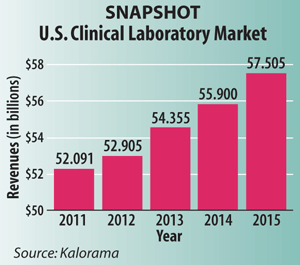Slower Growth Projected for Clinical Lab Service Market
Despite positive trends such as an aging population that is increasing demand for lab tests and a greater emphasis on preventive testing, growth in the U.S. clinical lab services market will be slowed over the next several years due to attempts to rein-in healthcare spending. Those were among the findings of "The Clinical Laboratory Service Market," a report produced by Kalorama Information. Kalorama based its conclusions on reviews of investment reports, company literature and the like, as well as interviews with more than 50 key industry officials.
The report pegged the U.S. market at about $52.1 billion in 2011, a 1.6% increase from 2010, and projected a compound growth rate of 2.5% between 2011 and 2015, with the market by 2015 valued at an estimated $57.5 billion.

An "overwhelming response" aimed at decreasing healthcare spending has already and will continue to have a tempering effect on an otherwise favorable growth outlook. The report cited government regulations, limits on reimbursement, and a reduction in specialty test coverage as issues slowing expansion in the industry. The recent overhaul of the lab fee schedule has lead to reimbursement cuts for almost all tests, according to the report.
On the plus side, with the average hospital length of stay now at 4.7 days—down from 4.9 days in 2000—physicians have less contact with patients and are leaning more on labs to gather, interpret, and deliver information that helps them monitor patients' conditions and overall health. Key areas of growth include genomic and esoteric testing, anatomic pathology, and specialized testing in oncology and infectious diseases. The market share for specialty tests, currently about 36%, is expected to grow faster than routine testing, due to both greater testing volume and often higher per-test prices. The report also cited an uptick in preventive and risk factor testing in oncology, endocrinology, and gynecology. In addition, new technologies and expanded applications for personalized medicine are expected to fuel growth.
The full report is available for purchase online.